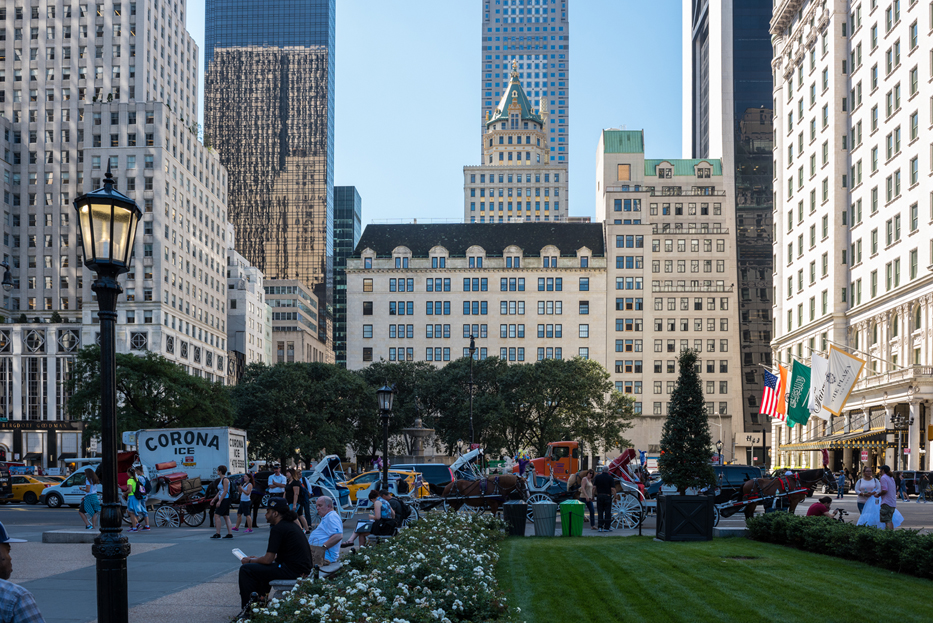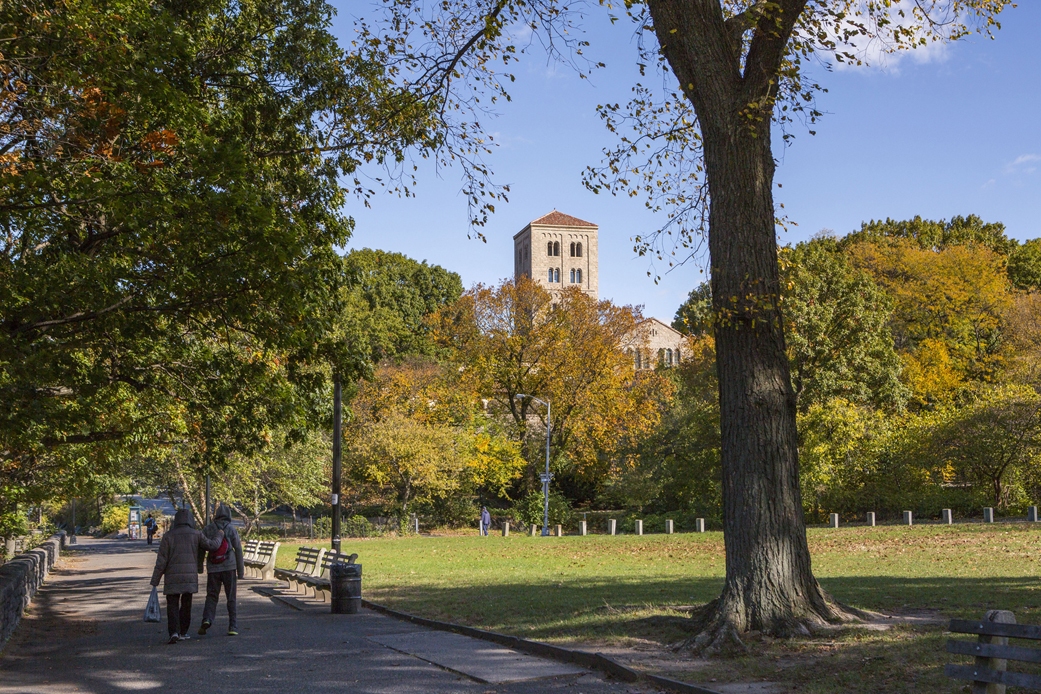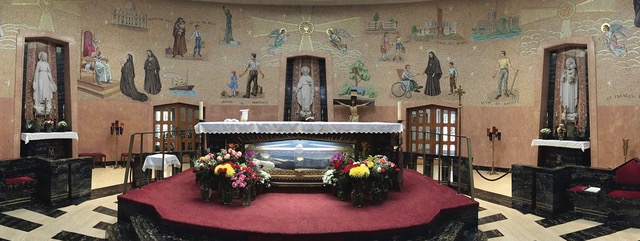
No other city in the world captures the imagination quite like New York. Its landmark attractions are known the world over and its financial and cultural power has shaped the nation.
Following the American Revolution, this one time Dutch Protestant colony became the cradle of a diverse and vibrant Catholic population. The city’s own cloud of heavenly witnesses reflect this heritage, from the enslaved Haitian-born Venerable Pierre Toussaint to the Italian born St. Francis Xavier Cabrini. It’s rich Catholic history is just waiting to be discovered.
Lower Manhattan
A journey through Lower Manhattan combines some of New York’s most iconic attractions – One World Trade Center, the National 9/11 Museum, the Brooklyn Bridge, Statue of Liberty, and Wall Street – with the chance to get to know St. Elizabeth Ann Seton and Servant of God Vincent Capodanno.

St. Elizabeth Ann Seton – best known for her zeal in establishing the Catholic parochial school system in America (as well as the first Catholic orphanage in America) – had her beginnings here. As a devout Presbyterian, it was here in Lower Manhattan that she lived most of her life. It was also at nearby St. Peter’s Church (see below) that she was received into the Catholic faith. The house in which she lived is now the Church of Our Lady of the Rosary and Shrine of Elizabeth Ann Seton. Her daughter, who also converted and joined the religious order established by her mother, went on to serve for decades in prison ministry across New York City.

The Seton Shrine is a stone’s throw away from the Staten Island ferry terminal. The free ride across New York Harbor to Staten Island is a fun and easy way to see the Statue of Liberty, Ellis Island, the Brooklyn Bridge and to take in views of the New York skyline. You might even be lucky enough to ride the fleet’s newest ship, named after Dorothy Day (the New York activist who started the Catholic Worker movement and is being considered for sainthood); she rode the ferry often to reach her cottage on Staten Island.

Staten Island is the hometown of one of America’s most courageous Catholics: the “Grunt Padre,” Navy chaplain, Servant of of God Vincent Capodanno, who was killed on duty during the Vietnam War while running to rescue comrades coming under attack from the North Vietnamese.
Fr. Capodanno was posthumously awarded the Medal of Honor and there are many tributes across Staten Island – including a memorial chapel and moving sculpture on display at historic Fort Wadsworth. Pilgrims can also pray at his grave at St. Peter’s Cemetery, adjacent to the Staten Island Zoo.

Returning to Lower Manhattan, another significant site is St. Peter’s Church. It is the oldest Catholic Church in New York and had many notable Catholics among its daily mass attendees, including St. Elizabeth Ann Seton, Venerable Pierre Toussaint, and the Cuban hero Venerable Felix Varelas.
It is often forgotten that many of the unsung heroes on 9/11 were Catholic emergency responders – police, fire, ambulance – who put their lives at risk. Their heroic witness is commemorated in the Catholic 9/11 Memorial at St. Peter’s; the memorial consists of statues of four saints – St. Joseph, St. Mary Magdalene, St. Florian, and St. Michael – each representing different virtues on display in the response to that tragedy.

On the exterior of the church, right at the corner of Barclay and Church Streets, is another poignant memorial to the tragedy: a steel crucifix that was erected to replicate a steel cross of twisted girders that was found in the rubble of the World Trade Center (the original is now in the 9/11 Museum). At the center of this cross is a piece of rubble from the World Trade Center. When it rains, the rust emerges as the blood from the wounded heart of Christ. Even though all the surrounding buildings were damaged on 9/11, St. Peter’s remained miraculously unscathed.
Little Italy and the East Village
New York has one of the oldest Little Italy neighborhoods in North America, lined with cheese shops, bakeries, and cafes that bring alive the senses as if you were back in the Old World.
Very near Little Italy, off of Mott Street, is the city’s first Catholic Cathedral: Old St. Patrick’s Basilica.

Old St. Patrick Cathedral was the first cathedral in the city, built in 1808. It was the site of St. John Neumann’s ordination to the episcopate in 1836 and remained the center of the city’s Catholic life well into the nineteenth century. One of the prominent men buried in the cathedral is John Curray, who as a boy, was one of the visionaries of Our Lady of Knock in Ireland, before moving to America. One fun fact: movie buffs will recognize the cathedral as the location of the Godfather movies.

One of the best times of the year to visit Little Italy is during the 11 day San Gennaro Festival, which runs from September 12 to 22 to honor the patron saint of southern Italy. The landmark church at the center of this festival is the Shrine Church of the Most Precious Blood, with its beautiful southern Italian artwork and the exposed relic of St. Vincenzo (a Roman soldier who was part of the infamous Thebian Legion of Roman soldiers who converted en masse to Christianity and was martyred in third century).

The nearby East Village is where the Catholic Worker movement of Servant of God Dorothy Day was born. Within the village is the Church of the Most Holy Redeemer, which houses the tomb of St. Datian third century Roman martyr. The reliquary shrines displays about 150 relics, including of Catholicism’s greatest saints including St. Mary Magdalene and St. Paul the Apostle (and even a splinter of the Nativity crib), surrounded by ex voto offerings of those who have been healed following prayer at this shrine. The church also has the honor of having been consecrated by St. John Neumann, America’s first male saint.

Midtown Manhattan
Midtown is home to many of New York’s most famous attractions: Times Square, 5th Avenue, Rockefeller Center, United Nations, Broadway, Radio City Music Hall, Central Park, and the Inteprid Air, Sea and Space Museum.
The energy coursing through Times Square at any time of day is undeniable. Right in the middle of the square is a prominent reminder of heroic Catholic virtue: an imposing statue of Lt. Col Francis P. Duffy, who was a military chaplain in the Spanish American War and the First World War, before becoming pastor of Holy Cross Church in New York’s theatre district.

A short walk from Times Square is the world famous strip of high end flagship stores and landmark buildings crowding Fifth Avenue: Saks Fifth Avenue, the Rockefeller Center, Trump Tower, and the Plaza Hotel. Directly across from the Rockefeller Center is St. Patrick’s Cathedral.
St. Patrick’s Cathedral was built with a very specific purpose in mind: to demonstrate to the city and the country that America’s Catholics had come of age and would not be cowed, after decades of being tormented by the anti-immigrant and anti-Catholic “Know Nothing” movement. The city’s first Archbishop, the Irish-born John Hughes, firmly resolved that his new Cathedral would be as grand as any of Manhattan’s Protestant churches.

The construction of this cathedral symbolized both the faith and dedication of the new immigrant communities. It officially opened in 1879 after almost two decades of work, largely paid for by the pennies, dimes and small-scale contributions of the working-poor in Manhattan. Many of the immigrant communities that helped build the church feel at home here: there are side altars to Poland’s Our Lady of Czestochowa, Our Lady of Guadalupe, Italy’s St. Anthony of Padua and France’s St. Jean Baptiste de la Salle.
Beneath the high altar, in the crypt where New York’s bishops are buried, is the tomb of a most exemplary New Yorker: the Venerable Pierre Toussaint. His story is inspiring. A former Haitian slave who followed his master to New York City, he worked by day as a hairdresser to the elite (and evangelist); by night, he returned to the household as a slave, to care for his widowed master. Even though he could have bought his freedom, he chose not to, fearing that his master would not let him work for her as a freed man. Upon her death in 1807, he was freed and together with his wife, opened their home to orphans – both white and black – and later raised funds for the city’s first Catholic orphanage and first Black school.
Central Park and Upper Manhattan

A whole day could easily be spent exploring Central Park and its surroundings. From the ice skating rink in the winter, sun bathing on the expansive lawns in the summer, year-round horse carriage rides, visiting the famed Strawberry Fields or Central Park Zoo, it is hard to run out of steam in Central Park. The park is ringed by notable churches and some of New York’s finest museums, including the Metropolitan Museum of Art, the Guggenheim, the Museum of Natural History, and the Frick Collection.

A block from the Park entrance at Columbus Circle is St. Paul the Apostle Church; the Mother Church of the Paulist Order of priests. Modeled after the Byzantine churches of fourth century Ravenna, Italy, this expansive church houses the tomb of Servant of God, Fr. Isaac Hecker, the founder of the Missionary Society of St. Paul the Apostle, “the Paulists,” in 1858.
The Paulists are a uniquely American order of priests; they were the first male religious community established in the U.S. and took on a distinct mission of being North American missionaries, spreading out across the south and west of the United States. Father Hecker and his co-founders were all converts from various Protestant traditions and so their ministry was very focused on conversion of American Protestants and engaging directly with popular culture and various forms of new media to evangelize.

Nestled among the high end apartments, shops, restaurants and museums that line Museum Mile in Upper Manhattan are some beautiful old Catholic Churches: the Jesuit church of St. Ignatius of Loyola (in addition to its breathtaking architecture, it is also renowned for its sacred music performances); and the Church of St. Jean Baptiste, originally built for the French-speaking community in New York. It holds the shrine of St. Anne, mother of Mary, with a part of the relic from the famous shrine in Canada.
Washington Heights

Beyond the northern boundary of Central Park is arguably New York’s most important shrine and the ultimate pilgrimage destination: the Shrine of St. Francis Xavier Cabrini. It is easily accessible by subway (exit at 192nd street station) and can be combined with a visit to The Met’s Cloister’s Museum.

Mother Cabrini was one of the most remarkable women to ever set foot in America. She had originally desired to be a missionary to China, but Pope St. Leo XIII convinced her that the Lord was calling her to service among the poor immigrants settling in late nineteenth century America.
With New York as her base, she repeatedly criss-crossed the country to minister to the Italians who were arriving en masse, everywhere from Chicago and New Orleans to Denver to Los Angeles and Seattle. Unlike the Irish immigrants who preceded the Italians by a generation, the Italian workers did not speak the language or have any cultural familiarity with America. Mother Cabrini and her sisters opened orphanages, schools, and hospitals across the U.S., while begging for alms and delivering food and clothing to the needy and helping the unemployed find work.

At the shrine, pilgrims can pray at the saint’s tomb, located in the chapel of the Mother Cabrini high school, built in 1891 by her Missionary Sisters of the Sacred Heart of Jesus. A carriage used by Mother Cabrini during her journeys is also on display.
The Cabrini Shrine is in very close proximity to one of New York’s most unique and popular museums, the Cloisters, a museum dedicated to medieval architecture and art, affiliated with the Metropolitan Museum of Art. It houses completely reconstructed cloisters taken from medieval monasteries and abbeys in Europe an interesting spot to end your trip.
Leave a comment